Spatial Variation in Risk for Highly Pathogenic Avian Influenza Subtype H5N6 Viral Infections in South Korea: Poultry Population-Based Case–Control Study
Abstract
1. Introduction
2. Materials and Methods
3. Spatial Autocorrelation and Clustering of Point Process Data
4. Methodology 1
5. Methodology 2
6. Results and Discussion
7. Conclusions
Supplementary Materials
Author Contributions
Funding
Institutional Review Board Statement
Informed Consent Statement
Data Availability Statement
Acknowledgments
Conflicts of Interest
References
- Sun, L.; Ward, M.P.; Li, R.; Xia, C.; Lynn, H.; Hu, Y.; Xiong, C.; Zhang, Z. Global spatial risk pattern of highly pathogenic avian influenza H5N1 virus in wild birds: A knowledge-fusion based approach. Prev. Veter Med. 2018, 152, 32–39. [Google Scholar] [CrossRef] [PubMed]
- Kwon, J.-H.; Lee, D.H.; Swayne, D.E.; Noh, J.Y.; Yuk, S.S.; Erdene-Ochir, T.O.; Hong, W.T.; Jeong, J.H.; Jeong, S.; Gwon, G.B.; et al. Highly pathogenic avian influenza A (H5N8) viruses reintroduced into South Korea by migratory waterfowl, 2014–2015. Emerg. Infect. Dis. 2016, 22, 507. [Google Scholar] [CrossRef] [PubMed]
- Artois, J.; Jiang, H.; Wang, X.; Qin, Y.; Pearcy, M.; Lai, S.; Shi, Y.; Zhang, J.; Peng, Z.; Zheng, J.; et al. Changing geographic patterns and risk factors for avian influenza A (H7N9) infections in humans, China. Emerg. Infect. Dis. 2018, 24, 87–94. [Google Scholar] [CrossRef]
- An, M.; Vitale, J.; Han, K.; Ng’ombe, J.N.; Ji, I. Effects of Spatial Characteristics on the Spread of the Highly Pathogenic Avian Influenza (HPAI) in Korea. Int. J. Environ. Res. Public Health 2021, 18, 4081. [Google Scholar] [CrossRef] [PubMed]
- Shin, J.; Kang, S.; Byeon, H.; Cho, S.M.; Kim, S.Y.; Chung, Y.J.; Jung, S.H. Highly pathogenic H5N6 avian influenza virus subtype clade 2.3. 4.4 indigenous in South Korea. Sci. Rep. 2020, 10, 7241. [Google Scholar] [CrossRef] [PubMed]
- Lee, H.-Y.; Lee, H.Y.; Oh, M.N.; Park, Y.S.; Chu, C.; Son, T.J. Public health crisis preparedness and response in Korea. Osong Public Heal. Res. Perspect. 2013, 4, 278–284. [Google Scholar] [CrossRef][Green Version]
- Kulldorff, M. Spatial scan statistics: Models, calculations, and applications. In Scan Statistics and Applications; Springer: New York, NY, USA, 1999; pp. 303–322. [Google Scholar]
- Hohl, A.; Zheng, M.; Tang, W.W.; Delmelle, E.; Casas, I. Spatiotemporal point pattern analysis using Ripley’s K function. Geospat. Data Sci. Tech. Appl. 2017, 155–176. [Google Scholar] [CrossRef]
- Dixon, P.M. Ripley’s K function. Encycl. Env. 2002, 3, 1796–1803. [Google Scholar]
- Kim, W.; Bae, S.; Cho, S. Spatiotemporal Dynamics of Highly Pathogenic Avian Influenza Subtype H5N8 in Poultry Farms, South Korea. Viruses 2021, 13, 274. [Google Scholar] [CrossRef]
- Yoo, D.-S.; Chun, B.; Min, K.D.; Lim, J.S.; Moon, O.K.; Lee, K.N. Elucidating the Local Transmission Dynamics of Highly Pathogenic Avian Influenza H5N6 in the Republic of Korea by Integrating Phylogenetic Information. Pathogens 2021, 10, 691. [Google Scholar] [CrossRef]
- Hu, Y.; Wang, F.H.; Guinc, C.; Zhu, H.J. A spatio-temporal kernel density estimation framework for predictive crime hotspot mapping and evaluation. Appl. Geogr. 2018, 99, 89–97. [Google Scholar] [CrossRef]
- Li, M.; Shi, X.; Li, X.; Ma, W.J.; He, J.F.; Liu, T. Sensitivity of disease cluster detection to spatial scales: An analysis with the spatial scan statistic method. Int. J. Geogr. Inf. Sci. 2019, 33, 2125–2152. [Google Scholar] [CrossRef]
- Gardener, M. Beginning R: The Statistical Programming Language; John Wiley & Sons: New York, NY, USA, 2012. [Google Scholar]
- Bivand, R.; Package ‘Rgdal’. Bindings for the Geospatial Data Abstraction Library. Available online: https://cran.r-project.org/web/packages/rgdal/index.html (accessed on 15 August 2021).
- Hijmans, R.J. Package ‘raster’. R Package 2015, 734. [Google Scholar]
- Wickham, H.; Chang, W.; Wickham, M.H. Package ‘ggplot2′. Create Elegant Data Visualisations Using the Grammar of Graphics. Version 2016, 2, 1–189. [Google Scholar]
- Lemon, J. Plotrix: A package in the red light district of R. R-News 2006, 6, 8–12. [Google Scholar]
- Furrer, R.; Nychka, D.; Sain, S.; Nychka, M.D. “Package ‘fields’.” R Foundation for Statistical Computing, Vienna, Austria. 2009. Available online: http://www.idg.pl/mirrors/CRAN/web/packages/fields/fields.pdf (accessed on 15 August 2021).
- Cheng, J.; Karambelkar, B.; Xie, Y.H.; Wickham, H.; Russell, K.; Johnson, K.; Schloerke, B.; jQuery Foundation and Contributors; Agafonkin, V.; CloudMade; et al. Create Interactive Web Maps with the JavaScript ‘leaflet’library. R Package Version 2.0. 4.1. 2021. Available online: https://rdrr.io/cran/leaflet/ (accessed on 15 August 2021).
- Bivand, R.; Koh, N.L.; Pebesma, E.; Archer, E.; Baddeley, A.; Bearman, N.; Bibiko, H.J.; Brey, S.; Callahan, J.; Carrillo, G.; et al. Maptools: Tools for Reading and Handling Spatial Objects. R Package Version 0.8-39. 2016. Available online: https://cran.R-project.Org/package=maptools (accessed on 15 August 2021).
- Neuwirth, E.; Neuwirth, M.E. Package ‘RColorBrewer’. ColorBrewer Palettes 2014. Available online: https://cran.r-project.org/web/packages/RColorBrewer/ (accessed on 15 August 2021).
- Sarkar, D.; Andrews, F.; Wright, K.; Klepeis, N.; Larsson, J.; Murrell, P.; Sarkar, D. Package ‘Lattice’. Version 0.20 2015, 33. Available online: http://lattice.r-forge.r-project.org/ (accessed on 15 August 2021).
- Ribeiro Jr, P.J.; Diggle, P.J.; Ribeiro Jr, M.P.J.; Suggests, M.A.S.S. The geoR package. R news 1.2 2007, 1, 14–18. [Google Scholar]
- Fox, J.; Friendly, G.G.; Graves, S.; Heiberger, R.; Monette, G.; Nilsson, H.; Ripley, B.; Weisberg, S.; Fox, M.J.; Suggests, M.A. The Car Package. R Found. Stat. Comput. 2007, 1109. Available online: https://cran.r-project.org/web/packages/car/index.html (accessed on 15 August 2021).
- Pebesma, E.; Bivand, R.S. S classes and methods for spatial data: The sp package. R news 5.2 2005, 5, 9–13. [Google Scholar]
- Bivand, R.; Anselin, L.; Bernat, A.; Carvalho, M.; Dray, S.; Halbersma, R.; Lewin-Koh, N.; Ono, H.; Tiefelsdorf, M.; Yu, D.L. The Spdep Package. Compr. R Arch. Netw. Version 2005, 05–83. Available online: https://cran.r-project.org/web/packages/spdep/index.html (accessed on 15 August 2021).
- Paradis, E.; Schliep, K. ape 5.0: An environment for modern phylogenetics and evolutionary analyses in R. Bioinformatics 2019, 35, 526–528. [Google Scholar] [CrossRef] [PubMed]
- Giraudoux, P.; Pgirmess: Data Analysis in Ecology. R Package Version 1.6.7. Available online: https://CRAN.R-project.org/package=pgirmess (accessed on 15 August 2021).
- Baddeley, A.; Rubak, E.; Turner, R. Spatial Point Patterns: Methodology and Applications with R; Chapman and Hall/CRC Press: London, UK, 2015. [Google Scholar]
- Bivand, R. Package ‘splancs’. R Package Version 2017, 2.01–40. Available online: https://www.maths.lancs.ac.uk/~rowlings/Splancs/ (accessed on 15 August 2021).
- French, J. Smacpod: Statistical Methods for the Analysis of Case-Control Point Data. R Package Version 2018, 2, 4. [Google Scholar]
- Hamner, B.; Frasco, M.; LeDell, E. Package ‘Metrics’. R Foundation for Statistical Computing. 2018. Available online: https://cran.r-project.org/ (accessed on 15 August 2021).
- Warnes, G.R.; Bolker, B.; Lumley, T.; Warnes, M.G.R. Package ‘gtools’. R Package Version 2015, 3, 1. [Google Scholar]
- Bates, D.; Maechler, M.; Bolker, B.; Walker, S.; Christensen, R.H.B.; Singmann, H.; Dai, B.; Scheipl, F.; Grothendieck, G.; Green, P. Package ‘lme4’. Version 2018, 1, 437. [Google Scholar]
- Whitcher, B.; Schmid, V.J.; Thorton, A. Working with the DICOM and NIfTI Data Standards in R. J. Stat. Softw. 2011, 44, 1–29. [Google Scholar] [CrossRef]
- Wickham, H.; Wickham, M.H. Package ‘Tidyverse’. 2019, pp. 1–5. Available online: https://tidyverse.tidyverse.org/ (accessed on 15 August 2021).
- Chen, S. Optimal bandwidth selection for kernel density functionals estimation. J. Probab. Stat. 2015, 2015, 1–21. [Google Scholar] [CrossRef]
- Kelsall, J.E.; Diggle, P.J. Non-parametric estimation of spatial variation in relative risk. Stat. Med. 1995, 14, 2335–2342. [Google Scholar] [CrossRef]
- Waller, L.A.; Gotway, C.A. Applied Spatial Statistics for Public Health Data; John Wiley & Sons: New York, NY, USA, 2004; Volume 368. [Google Scholar]
- Carlos, H.A.; Shi, X.; Sargent, J.; Tanski, S.; Berke, E.M. Density estimation and adaptive bandwidths: A primer for public health practitioners. Int. J. Health Geogr. 2010, 9, 1–8. [Google Scholar] [CrossRef]
- King, T.L.; Bentley, R.J.; Thornton, L.E.; Kavanagh, A.M. Using kernel density estimation to understand the influence of neighbourhood destinations on BMI. BMJ Open 2016, 6, e008878. [Google Scholar] [CrossRef] [PubMed]
- Diggle, P.J.; Chetwynd, A.G. Second-order analysis of spatial clustering for inhomogeneous populations. Biometrics 1991, 47, 1155–1163. [Google Scholar] [CrossRef] [PubMed]
- Hill, S.C.; Hill, S.C.; Lee, Y.J.; Song, B.M.; Kang, H.M.; Lee, E.K.; Hanna, A.; Gilbert, M.; Brown, I.H.; Pybus, O.G. Wild waterfowl migration and domestic duck density shape the epidemiology of highly pathogenic H5N8 influenza in the Republic of Korea. Infect. Genet. Evol. 2015, 34, 267–277. [Google Scholar] [CrossRef] [PubMed]
- Kwon, J.H.; Bahl, J.; Swayne, D.E.; Lee, Y.N.; Lee, Y.J.; Song, C.S.; Lee, D.H. Domestic ducks play a major role in the maintenance and spread of H5N8 highly pathogenic avian influenza viruses in South Korea. Transbound. Emerg. Dis. 2019, 67, 844–851. [Google Scholar] [CrossRef]
- Webster, R.G.; Bean, W.J.; Gorman, O.T.; Chambers, T.M.; Kawaoka, Y. Evolution and ecology of influenza A viruses. Microbiol. Rev. 1992, 56, 152–179. [Google Scholar] [CrossRef]
- Chen, H.; Deng, G.; Li, Z.; Tian, G.; Li, Y.; Jiao, P.; Zhang, L.; Liu, Z.; Webster, R.G.; Yu, K. The evolution of H5N1 influenza viruses in ducks in southern China. Proc. Natl. Acad. Sci. USA 2004, 101, 10452–10457. [Google Scholar] [CrossRef]
- Hulse-Post, D.J.; Sturm-Ramirez, K.M.; Humberd, J.; Seiler, P.; Govorkova, E.A.; Krauss, S.; Scholtissek, C.; Puthavathana, P.; Buranathai, C.; Nguyen, T.D.; et al. Role of domestic ducks in the propagation and biological evolution of highly pathogenic H5N1 influenza viruses in Asia. Proc. Natl. Acad. Sci. USA 2005, 102, 10682–10687. [Google Scholar] [CrossRef]
- Sturm-Ramirez, K.M.; Hulse-Post, D.J.; Govorkova, E.A.; Humberd, J.; Seiler, P.; Puthavathana, P.; Buranathai, C.; Nguyen, T.D.; Chaisingh, A.; Long, H.T.; et al. Are ducks contributing to the endemicity of highly pathogenic H5N1 influenza virus in Asia? J. Virol. 2005, 79, 11269–11279. [Google Scholar] [CrossRef]
- Keawcharoen, J.; van Riel, D.; van Amerongen, G.; Bestebroer, T.; Beyer, W.E.; van Lavieren, R.; Osterhaus, A.D.; Fouchier, R.A.; Kuiken, T. Wild ducks as long-distance vectors of highly pathogenic avian influenza virus (H5N1). Emerg. Infect. Dis. 2008, 14, 600. [Google Scholar] [CrossRef]
- Sullivan, J.D.; Takekawa, J.Y.; Spragens, K.A.; Newman, S.H.; Xiao, X.M.; Leader, p.j.; Smith, B.; Prosser, D.J. Waterfowl spring migratory behavior and avian influenza transmission risk in the changing landscape of the east Asian-Australasian flyway. Front. Ecol. Evol. 2018, 6, 206. [Google Scholar] [CrossRef]
- Shimizu, Y.; Hayama, Y.; Yamamoto, T.; Murai, K.; Tsutsui, T. Matched case-control study of the influence of inland waters surrounding poultry farms on avian influenza outbreaks in Japan. Sci. Rep. 2018, 8, 1–4. [Google Scholar] [CrossRef] [PubMed]
- Ramey, A.M.; Reeves, A.B.; Lagassé, B.J.; Patil, V.; Hubbard, L.E.; Kolpin, D.W.; McCleskey, R.B.; Repert, D.A.; Stallknecht, D.E.; Poulson, R.L. Evidence for interannual persistence of infectious influenza A viruses in Alaska wetlands. Sci. Total Environ. 2021, 803, 150078. [Google Scholar] [CrossRef] [PubMed]
- OECD. Perspectives on Decentralisation and Rural-Urban Linkages in Korea; OECD: Paris, France, 2021. [Google Scholar]
- Bolibok, L. Limitations of Ripley’s K (t) function use in the analysis of spatial patterns of tree stands with heterogeneous structure. Acta Sci. Pol. Silvarum Colendarum Ratio Ind. Lignaria 2008, 7, 5–18. [Google Scholar]
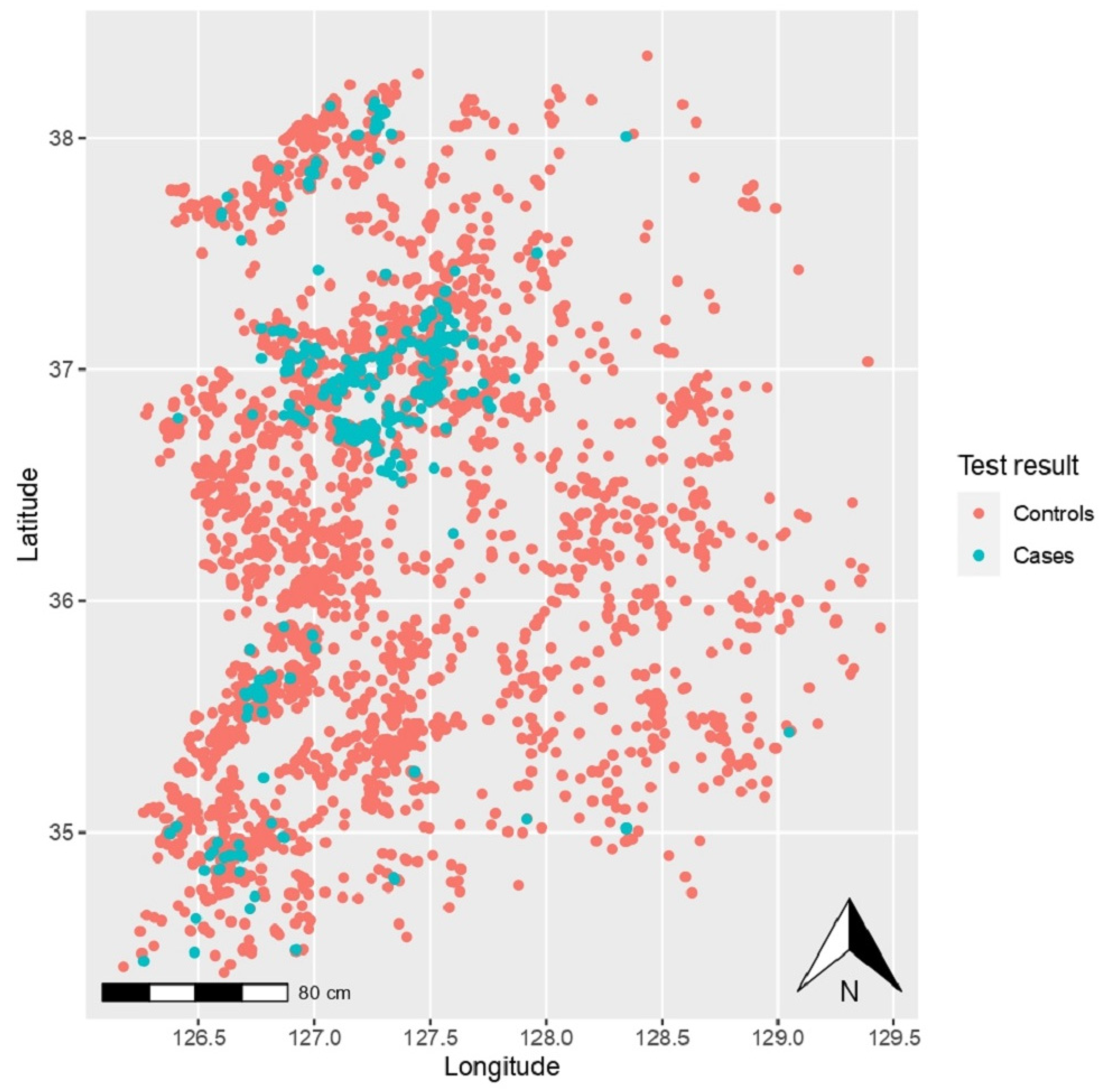
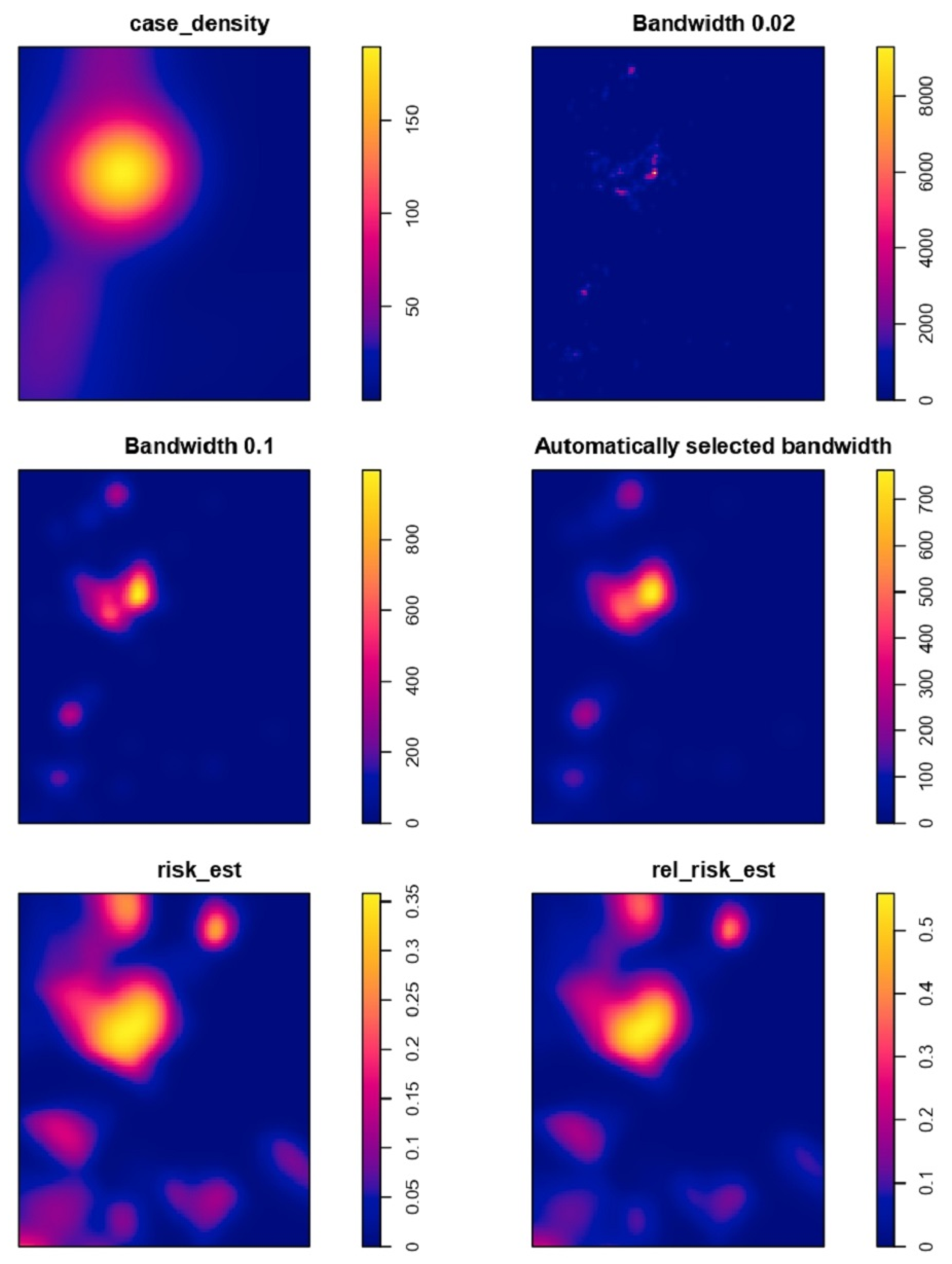
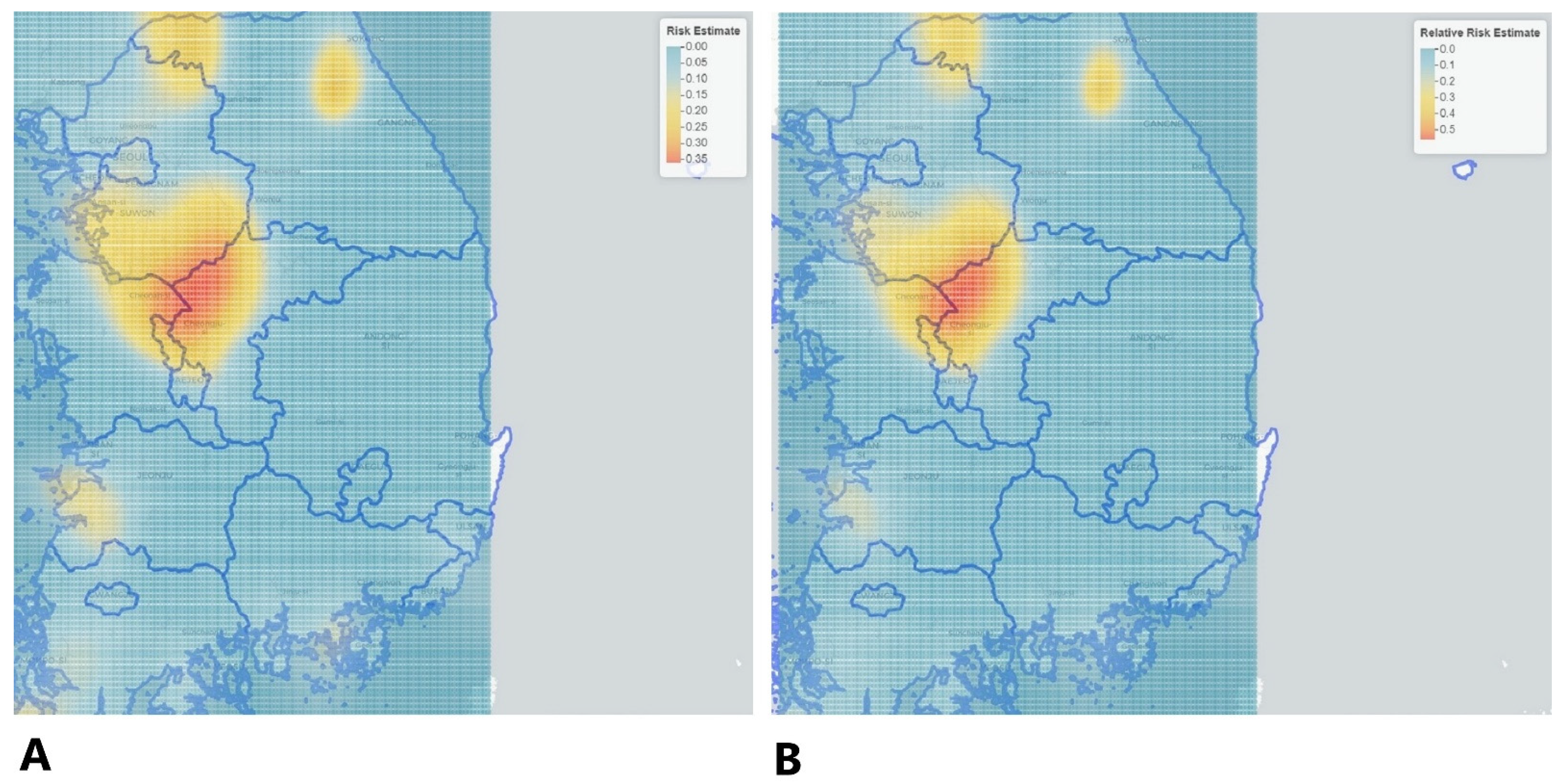
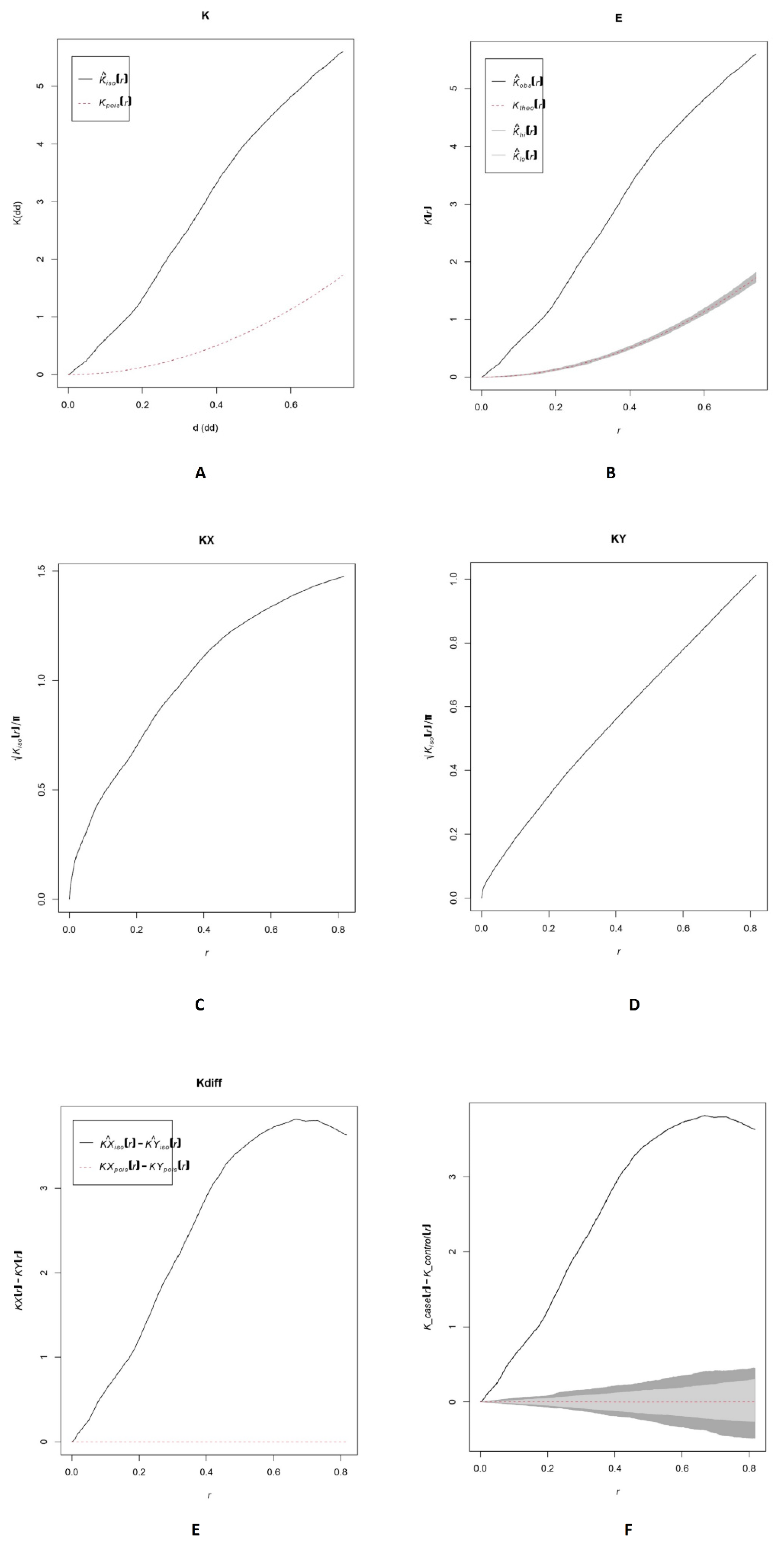
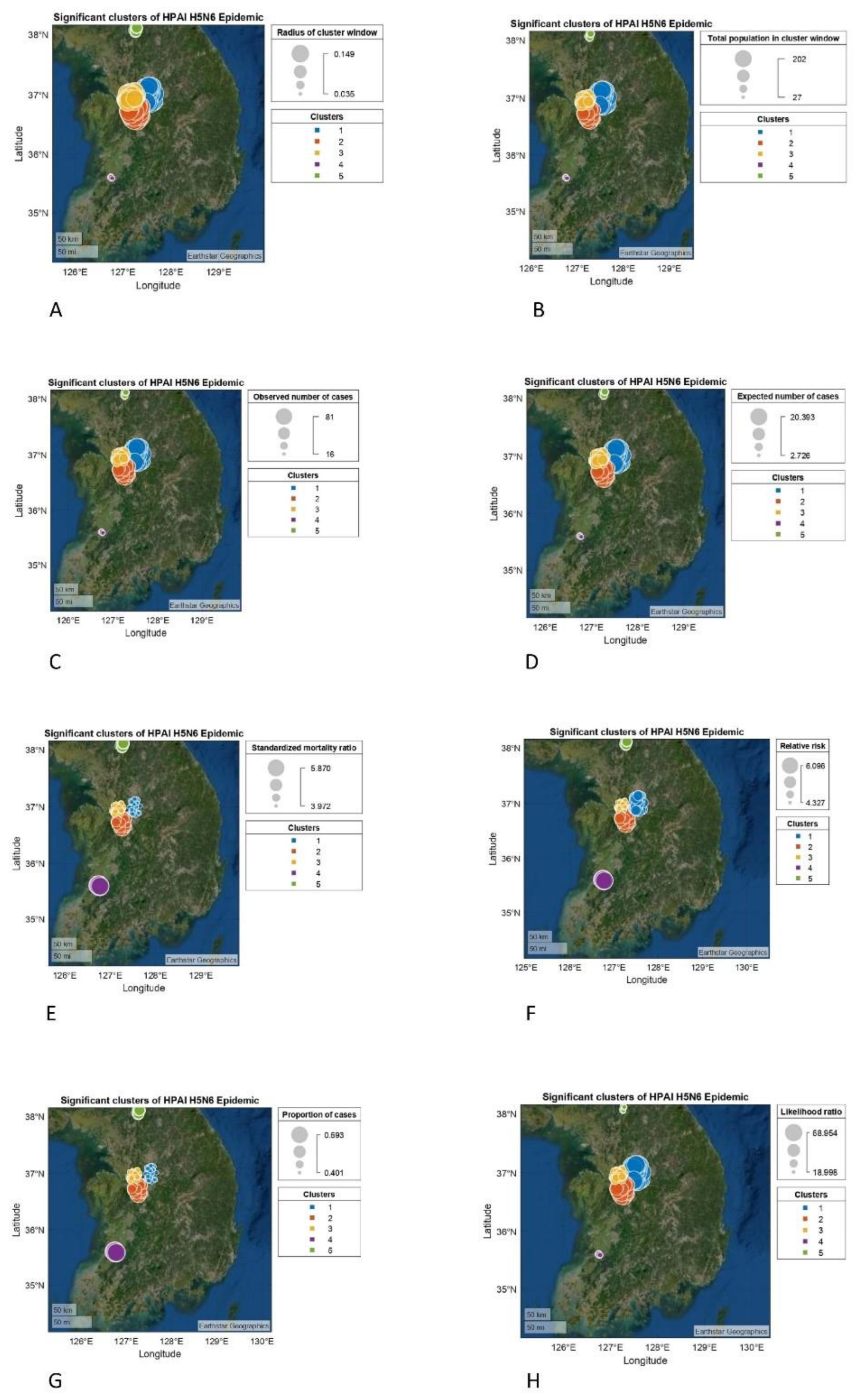
| Clusters | Cluster Centroid | Radius of the Cluster Window (km) | Total Population Cluster Window | Observed No. of Cases in Cluster Window | Expected No. of Cases in Cluster Window | Standardized Mortality Ratio | Risk Ratio | Proportion of Cases | Loglikelihood Ratio | p Value |
|---|---|---|---|---|---|---|---|---|---|---|
| Cluster 1 | Eumseong, Chungcheongbuk-do | 0.149 | 202 | 81 | 20.3926 | 3.97203 | 4.834 | 0.4009901 | 68.95386 | 0.001 ** |
| Cluster 2 | Cheonan, Chungcheongnam-do | 0.147 | 104 | 46 | 10.49916 | 4.381303 | 4.876 | 0.4423077 | 42.3304 | 0.001 ** |
| Cluster 3 | Cheonan, Chungcheongnam-do | 0.129 | 76 | 31 | 7.672462 | 4.040424 | 4.326 | 0.4078947 | 25.36896 | 0.001 ** |
| Cluster 4 | Jeongeup, Jeollabuk-do | 0.0350 | 27 | 16 | 2.725743 | 5.869959 | 6.096 | 0.5925926 | 19.88819 | 0.001 ** |
| Cluster 5 | Pocheon-si, Gyeonggi-do | 0.067 | 43 | 20 | 4.340998 | 4.607235 | 4.819 | 0.4651163 | 18.99753 | 0.001 ** |
Publisher’s Note: MDPI stays neutral with regard to jurisdictional claims in published maps and institutional affiliations. |
© 2022 by the authors. Licensee MDPI, Basel, Switzerland. This article is an open access article distributed under the terms and conditions of the Creative Commons Attribution (CC BY) license (https://creativecommons.org/licenses/by/4.0/).
Share and Cite
Ahmad, S.; Koh, K.-Y.; Yoo, D.-S.; Lee, J.-I. Spatial Variation in Risk for Highly Pathogenic Avian Influenza Subtype H5N6 Viral Infections in South Korea: Poultry Population-Based Case–Control Study. Vet. Sci. 2022, 9, 135. https://doi.org/10.3390/vetsci9030135
Ahmad S, Koh K-Y, Yoo D-S, Lee J-I. Spatial Variation in Risk for Highly Pathogenic Avian Influenza Subtype H5N6 Viral Infections in South Korea: Poultry Population-Based Case–Control Study. Veterinary Sciences. 2022; 9(3):135. https://doi.org/10.3390/vetsci9030135
Chicago/Turabian StyleAhmad, Saleem, Kye-Young Koh, Dae-Sung Yoo, and Jae-Il Lee. 2022. "Spatial Variation in Risk for Highly Pathogenic Avian Influenza Subtype H5N6 Viral Infections in South Korea: Poultry Population-Based Case–Control Study" Veterinary Sciences 9, no. 3: 135. https://doi.org/10.3390/vetsci9030135
APA StyleAhmad, S., Koh, K.-Y., Yoo, D.-S., & Lee, J.-I. (2022). Spatial Variation in Risk for Highly Pathogenic Avian Influenza Subtype H5N6 Viral Infections in South Korea: Poultry Population-Based Case–Control Study. Veterinary Sciences, 9(3), 135. https://doi.org/10.3390/vetsci9030135




